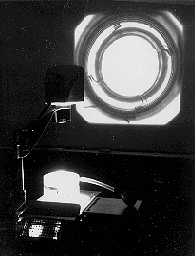

PURPOSE: To demonstrate the Feynman inverse sprinkler effect.
DESCRIPTION: When water is squirted out of a sprinkler, the sprinkler head rotates in the direction opposite to the water flow (called the normal direction) due to the reaction force on the head. This is like a Hero's engine, the rotational equivalent of a rocket. Q: If water is sucked into the sprinkler head (actually pushed by a larger ambient pressure in the water vessel) will the sprinkler head (a) rotate in the normal direction, (b) rotate in the inverse direction, or (c) remain motionless? A: When water is sucked into the sprinkler head, the sprinkler head will rotate in the direction opposite the water flow, or inverse, direction.
The cylindrical vessel with four nozzles pictured above floats in a larger container of water. When pressure is applied by squeezing the bulb, water is forced into the nozzles. During the transient time, while the water speed is increasing in the nozzles, a reaction force on the nozzles causes the sprinkler to begin rotating slowly in the inverse direction, so as to conserve angular momentum (at zero) with the water going into the nozzle. While the water flow is at a steady state the sprinkler head rotates with a constant angular speed. When the flow ceases, the sprinkler head stops and remains motionless. When the bulb is released and water flows out of the nozzles, the sprinkler undergoes large continuous acceleration in the forward, or normal, direction.
SUGGESTIONS: Before doing the experiment, let your students argue about what the sprinkler head will do in the inverse sprinkler mode.
REFERENCES: (PIRA 1Q40.85) See Demonstration Reference File for many articles dealing with this problem. See also Demonstration D3-22: INVERSE SPRINKLER - METAL MODEL.
EQUIPMENT: Inverse sprinkler in glass container with squeeze bulb, overhead projector.
SETUP TIME: 10 min.
 |  |  |  |  |